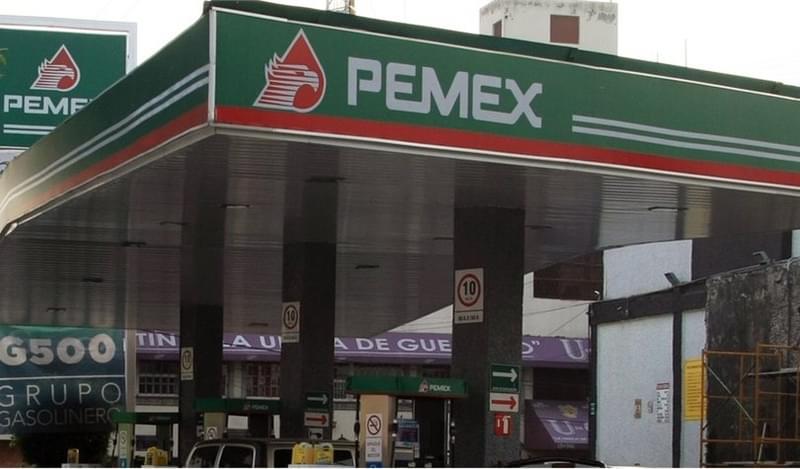Nothing highlights the extent of a fuel crisis more that hundreds of poor, desperate citizens gathering around an oil pipe to syphon gasoline into buckets or cans. Yet the precarious state of the energy sector in Mexico has not precipitated overnight. The industry has been highly inefficient for decades, and while Mexico’s previous leader, Enrique Peña Nieto, had the right idea in mind to shift away from a monopoly model and privatize it in 2013, little has changed five year on; that which has changed during that period has not been particularly positive. 
Over the past decade, crude oil production has fallen on average 4-5% per year, according to Forbes, dragging Mexico's share of global output down from 5% to 2%, with today’s output levels about 30% below the 3 million b/d that was promised by Peña Nieto back in 2015. According to the new energy minister, Rocio Nahle, as much as 80% of the gasoline needs of a 135mn-plus population are covered by imports due to the fact that its refineries work at mere 38% capacity.
The tragic incident in Tlahuelilpan was particularly painful as it came in the midst of a government clampdown on fuel theft – known locally as huachicoleo – announced by Andrés Manuel López Obrador as one of his priorities after coming to power, brought about USD3bn worth of losses, or twice the 3Q2018 net profit.
The new administration is looking to quickly bring the sector under manual control to manage the crisis, in a rebuff of the strategic plans laid in place by Pena Nieto’s government. It swiftly moved to shut down three major pipelines at the end of December and temporarily shifted distribution of fuel onto trucks. Naturally, that has led to questions being raised about the prospects of future auctions and the promised opening up of the sector.
“The liberalization process seen in the past years has a natural inertia difficult to stop, but certainly, it has slowed down since the new administration took power,” notes Guillermo Bilbao, an energy and utilities expert at PA Consulting.
Indeed, since the inauguration, two oilfield auctions were cancelled, one of which was related to strategically important non-conventional resources such as shale gas. Furthermore, farm out biddings were delayed from February to October 2019, and the rest of the E&P auctions have been suspended for the next 3 years in order to “see results of private sector participation before moving forward”, according to AMLO and Nahle.
Additionally, the new administration is supporting the state oil giant Pemex with renewed fervour, committing nearly MXN75bn (USD3.65bn) of federal funds (sourced from the government austerity programme) to supporting the company that is struggling under its USD100bn debt burden. AMLO also made plans to build a USD8bn oil refinery, as well as renovate six existing facilities; these developments are part of a plan to raise domestic oil and gas production by 50% by 2025.
In total, under the new National Plan for the Production of Hydrocarbons, the government is aiming to spend approximately USD19bn in 2019 on exploration and production, USD1.8bn more than in 2018. Contracts granted to previous auctions have been authorized by the National Hydrocarbon Commission (CNH) to invest USD9bn in infrastructure and production over the next six years. Both measures are aimed to raise production from 1.8 to 2.5 million of barrels per day by 2024.
Investors’ Woes
The scrapped auctions were the fourth in a series, with previous tenders, mostly for wind and solar power projects, already finalized and handed out to the bidders. AMLO has been a vocal critic of the energy reforms – just as he was of the New Mexico City Airport project, which was 30% completed when the new administration came in and cancelled it and focusing instead on expanding existing facilities. The parallels were plain to see and prospective investors were getting edgy.
So far, the threat has not materialized. Though AMLO has indicated that the fate of future contracts will depend on the outcome of the review of those already signed, and has publicly encouraged oil producers to deliver on the contracts quickly and efficiently, he also affirmed commitment to honouring exploration and production contracts already signed, both publicly and in private through calls with executives and investors.
When (or whether) these contracts will bear fruit will become apparent in due course, but there are encouraging signs, noted Bilbao. The expert points to cases such as Eni, which earned a contract for a field with an estimated potential of 2 billion barrels of oil equivalent and is expected to start production in 2019. Others include Fieldwood with Ichalkil-Pococh field, which is expected to produce an average of 40 thousand barrels per day starting in 2020, and Hokchi Energy, which will produce 28 thousand barrels per day by 2021.
“BHP Billiton, which won a farm-out contract with Pemex for producing deepwater oil in the Trion field, holding reserves estimated at 485 million barrels of crude in the Gulf of Mexico, recently announced plans to bump up exploratory activities and investments in their contracting area, in response to the new administration request,” the expert says.
“AMLO has mentioned that he will need private investments to accomplish his plans. The capital-intensive oil production will require the participation of private firms both in partnership with Pemex or through E&P contracts. So, farm-outs are very likely to continue and, hopefully, deepwater auctions will too, so that the risk is leveraged,” Bilbao explains, lamenting that non-conventional resources and renewables may not be so lucky, as the government has so far taken a firmer stance against “going green.”
Price to Pay
As Mexico’s new leader sets off to rollback or reshape the policies of his predecessor, the key question is at what cost – both fiscal, financial, and reputational. A source in a major international bank operating in Mexico admitted there are big question marks over Mexico’s energy sector this year.
“Investor exposure to the sovereign and quasi-sovereigns is at an all-time high, so it’s unclear how able they will be to take into existing pools of liquidity,” the source notes.
According to the transition team report from the previous administration, reaching production capacity of 2.9mn barrels per day by 2030 will require capital expenditure investments of USD26.5bn, with companies that won contracts, including Shell and Petronas, expected to invest USD46bn in exploration and development activities by 2025.
Beyond direct investments, the government is also focusing on developing new technologies to improve efficiency and raise production, by as much as 5%, through innovative tools such as artificial intelligence, data analytics, dark data, predictive techniques, which it hopes will help cut the costs. As Bilbao points out though, successful implementation of these techniques rests on support from international specialists in training Mexican engineers, non-interference from the bureaucracy and long-term commitment to innovation.
And beyond the technical side, for foreign companies that won the tenders, the lack of alternatives to Pemex in offloading their product at fair prices could represent a challenge.
“There is an opportunity in gathering, processing and logistics infrastructure between production sites and selling points, like seaports or refineries to reach the market; but all infrastructure is Pemex-owned and there are incipient alternatives. So far, from 2013 to 2018, companies that won the first batch of Round 1 tenders have invested USD700mn, but only 9% went to oil production,” Bilbao commented, noting that attractive purchasing and commercialization programmes could stimulate production and investment.
Regulatory Support
Much of the funding needs will inevitably fall on Pemex, already straining under its debt load, so state support will be essential. A series of measures announced by the AMLO administration in recent weeks should prop up the state oil firm, including a MXN75bn cash injection and some USD580mn a year through raising the limits of cost deduction for exploration and production projects, bringing them into line with the level seen in 2015-18 auctions.
Regulatory tweaks are another lever the state could exercise. In an announcement on January 29, the government implemented a bespoke tax regime for Pemex’s secondary and tertiary recovery, which will allow the company to boost the declining output of its mature fields – which, according to S&P Global, account for up to 70% of Mexico’s net output.
More broadly, plans to grant tax incentives on capital gains and corporate bond interest, announced in early January, should be supportive of Pemex alongside other corporates.
Under the decree, write Holland & Knight’s Eugenio Grageda, “a tax credit is granted to Mexican withholding agents, generally financial intermediaries or securities depositories, equivalent to 100 percent of the income tax to be withheld in Mexico under the Mexican Income Tax Law from interest payments to foreign resident investors. The effect of this incentive is in fact exempting the interests from withholding tax in Mexico.”
“This benefit will apply so long as the interests derives from publicly traded bonds issued by Mexican resident entities and the recipient is resident in a country with which Mexico has an income tax treaty or a broad exchange of information agreement, such as the United States”.
AMLO’s Gamble
Pemex is already a prolific issuer in Mexico, and the Finance minister has recently announced that the company will issue internal and external debt for USD10.3bn to finance operations and accomplish ambitious production goals. But with its USD100bn+ debt load, reputational damage from the prolonged fuel crisis in Mexico and the broad rise in yields in Latin America seen in the last quarter of 2019, costs of borrowing are on the rise.
Yields on the Pemex USD 2029 bond with a 6.5% coupon shot up 40bp to 7.6% following its two-day roadshow, on the back of the announcement to deleverage and boost output. As of January 29, Pemex’s 2027 dollar bonds saw yields rise 16bp to 7.02%, a 3-week high, leading to another downgrade from Fitch (two notches, BBB- from BBB+) and edging the company closer to junk level.
“The ratings are constrained by Pemex’s substantial tax burden, high leverage, significant unfunded pension liabilities, large capital investment requirements, negative equity and exposure to political interference risk,” Fitch said in a statement.
For the sovereign the premium so far has been less painful, as yields came down from the end of year highs of 215bp over USTs to around 185bp mark on the country’s 2019 bond market return, a USD2bn 10-year issue. That, however, was still above its previous 135bp premium paid a year ago for a similar issuance.
Capital markets have also played an important role for the sector from a budget stabilization perspective, with the country spending around USD1.2bn in 2018 on the oil price hedges as the cost of crude fluctuated wildly through 2018. While, according to media reports, it is already close to completing forward oil price hedges for 2019, it remains to be seen whether the new administration plans to continue with this policy in the long run.
“Given the volatility of hydrocarbons prices in 2018, it is imperative to continue with the hedging strategy that the previous government established,” Bilbao affirmed. “The Finance Minister, Carlos Urzua, one of the most moderate members of the cabinet, presented the 2019 Federal Budget with a Mexican Exportation Oil price at USD55 per barrel, and is likely to continue with the hedging strategy in the upcoming years.”
In the near-term perspective, AMLO’s gamble on the energy sector may well pay off, on condition that he holds up his end of the bargain by respecting the existing contracts to maintain investor confidence and improving the efficiency and transparency of future auctions. In the medium-to-long, though, abandoning the country’s environmental goals and failing to diversify the power sector, given the growing allocation of ESG asset in global investor portfolios and the success of “green” financing of projects and initiatives across Latin America, it may turn out that this energy may have been better spent on renewables.









